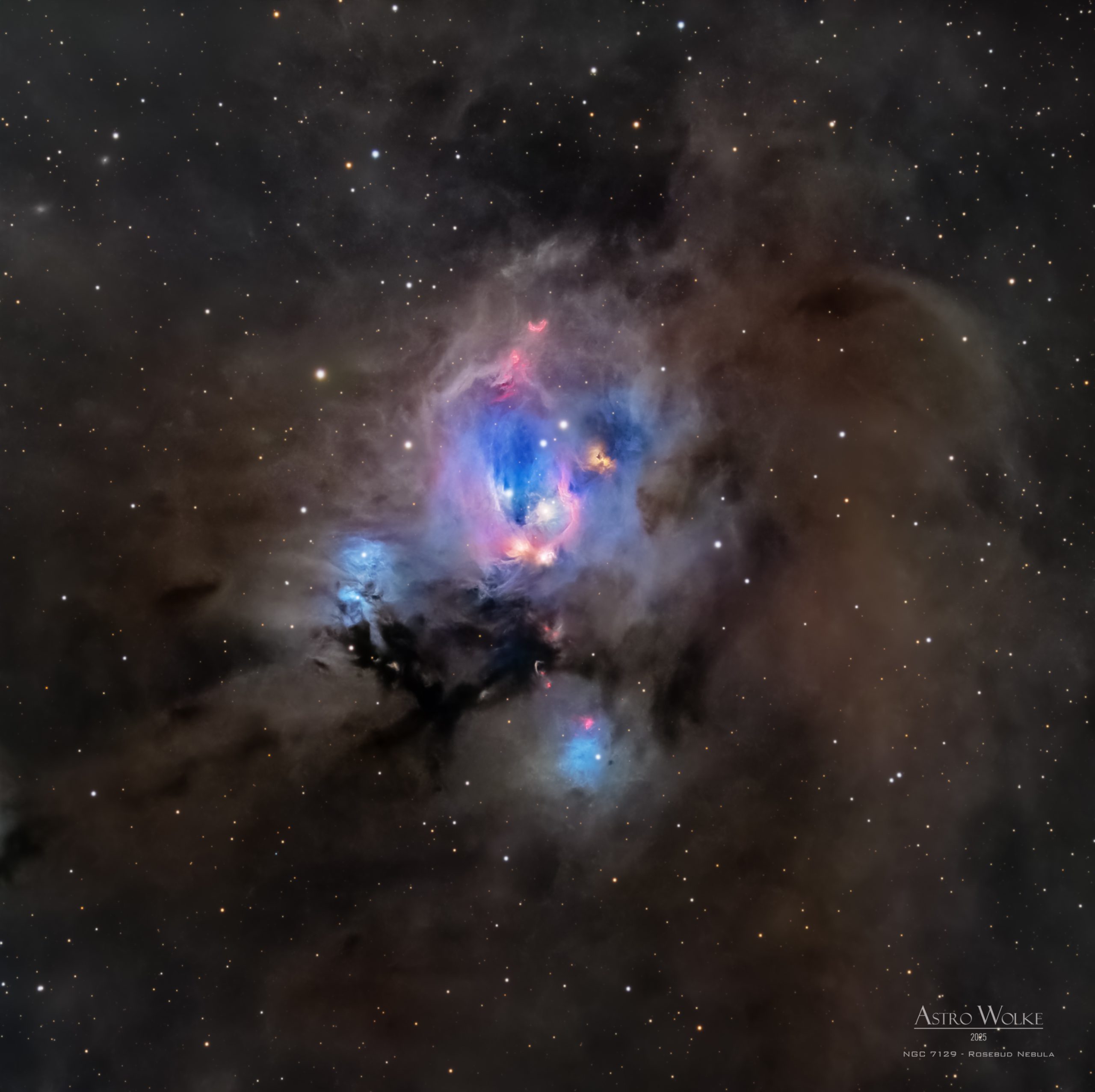NGC 7129 – Rosebud Nebula
In the faint constellation of Cepheus, about 3,300 light-years away, lies a delicate blue reflection nebula known as NGC 7129. Though invisible to the naked eye, it shines beautifully in long-exposure photographs — a hidden jewel of the northern sky.
Inside this region, clusters of young, hot stars illuminate nearby clouds of gas and dust. Their light is scattered by fine dust particles, giving the nebula its characteristic blue glow. These stars are only a few million years old — mere infants on the cosmic timescale. Their intense radiation and stellar winds carve cavities and sculpt the surrounding material into graceful shapes.
Around the central cluster, faint red filaments mark regions of glowing hydrogen gas where new stars are still forming. Astronomers also observe Herbig–Haro objects here — bright knots of gas created when jets from young stars collide with surrounding matter at high speed.
NGC 7129 offers a glimpse into the early, turbulent stages of stellar birth — a place of light, dust, and motion. For astrophotographers, it is one of the most rewarding targets of the autumn sky: a striking interplay of blue reflection nebulae, red emission zones, and dark lanes of dust. A cosmic painting that tells the timeless story of how new suns are born.
NGC 7129 – Rosenknospen Nebel
Im unscheinbaren Sternbild Kepheus, etwa 3.300 Lichtjahre von der Erde entfernt, leuchtet eine zarte, bläuliche Wolke: NGC 7129, ein Reflexionsnebel, in dem neue Sterne geboren werden. Obwohl er auf Fotografien farbenprächtig erscheint, ist er mit bloßem Auge unsichtbar – ein verborgenes Juwel des nördlichen Himmels.
Das Licht junger, heißer Sterne in seinem Inneren wird von feinen Staubpartikeln gestreut, wodurch der Nebel in einem kalten, blauen Schimmer erstrahlt. Diese Sterne sind erst wenige Millionen Jahre alt – im Maßstab des Universums sind sie also kaum älter als Kinder. Ihre Strahlung und Sternenwinde formen die Wolke ständig um und blasen Hohlräume in das Gas.
Rund um NGC 7129 verlaufen rötliche Filamente aus leuchtendem Wasserstoffgas, in denen sich neue Sterne bilden. Hier entstehen sogenannte Herbig-Haro-Objekte – Leuchtknoten, die entstehen, wenn Gas aus jungen Sternen mit großer Geschwindigkeit auf die umgebende Materie trifft.
NGC 7129 ist damit ein Paradebeispiel für die frühe Phase der Sternentstehung: chaotisch, leuchtend, von Kräften und Gegensätzen geprägt. Für Astrofotografen zählt er zu den reizvollsten Motiven des Herbsthimmels. Mit langen Belichtungszeiten offenbart sich ein faszinierendes Zusammenspiel aus blauen Reflexionsnebeln, rötlichen Emissionszonen und dunklen Staubbändern – ein kosmisches Gemälde, das von der Geburt junger Sonnen erzählt.
Details
Total Integration: 31h 45‘
R: 69x180s (3h27’) – 01.10.2025
G: 86x10s (4h18’) – 02.10.20225
B: 69x180s (3h27’) – 02.10.2025
L: 333x180s (16h39’) – 23./24.08./30.09.2025
Ha: 78x180s (3h 54’) – 03.10.2025
FOV: 0.42° x 0.42°
Pixel scale: 0.53″/pixel
Dithering: 2 pixels every image
Gain: 100
Sensor temperature: 0°C
Recording: ZWO ASI 533 MM
Filter: Baader CMOS 2’’
Optics: Celestron C8EHD + Celestron Reducer 0.7x
Guiding: ZWO ASI 220 MM / ZWO OAG-L
Mount: iOptron CEM70
Control: ZWO ASIAIR Plus
Software: PixInsight + Photoshop
Darks: 30
Flats: 20
Flat-Darks: 20


Comments are closed